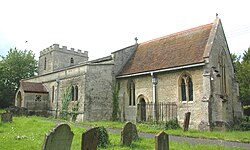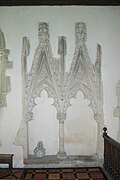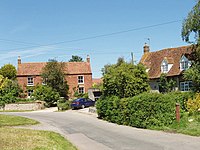Piddington, Oxfordshire
| Piddington | |
| Oxfordshire | |
|---|---|
 St Nicholas, Piddington | |
| Location | |
| Grid reference: | SP628167 |
| Location: | 51°51’7"N, 1°4’16"W |
| Data | |
| Population: | 370 (2011) |
| Post town: | Bicester |
| Postcode: | OX25 |
| Dialling code: | 01869 |
| Local Government | |
| Council: | Cherwell |
| Parliamentary constituency: |
Banbury |
Piddington is a village in Oxfordshire about four and a half miles south-east of Bicester. It stands close to the border with Buckinghamshire, across which sits Ludgershall
The name 'Piddlington has been attributed to the Old English Pyda's tun.[1]
The 2011 Census recorded the parish's population as 370.
Contents
Manor
The Domesday Book of 1086 records that before the Norman Conquest, Hacun held the manor of Piddington, and also the nearby manor of Merton.[1] It also records that by 1086 Judith, Countess of Huntingdon, a niece of William the Conqueror held the manor.[1] After the Revolt of the Earls in 1075 Judith's husband Waltheof, Earl of Northumbria was executed and the King betrothed her to Simon I de Senlis. She refused to marry him and fled England, so William confiscated her estates and allowed Simon to marry Judith's eldest daughter Maud. Simon received estates including Merton and Piddington as part of the honour of Huntingdon.[1]
In 1152 Simon II de Senlis inherited Piddington and almost immediately granted it to the Priory of St Frideswide, Oxford.[1] In 1153 Simon II died, and his heir King Malcolm IV of Scotland, confirmed the grant of Piddington to the Priory.[1] However, Malcolm's heir-apparent William the Lion took Piddington back from the Priory.[1] In about 1174, Henry II deprived William of all his titles and lands in England and granted the Earldom of Huntingdon to Simon III de Senlis.[1] Simon acknowledged the Priory's claim to Piddington but continued to hold the overlordship himself, even ignoring a Papal bull upholding the Priory's rights.[1]
The following centuries saw many changes in the ownership of the manor. I 1359 the Priory finally succeeded in regaining Piddington,[1] and retained until 1525, when Cardinal Wolsey suppressed the Priory to found his Cardinal's College.[1] In 1530 Henry VIII deposed Wolsey and in 1532 Piddington passed to Christ Church, Oxford.[1]
However, in 1553 Piddington was granted to Thomas Dynham, and it passed then though the family and collateral lines. Sir Henry Aubrey-Fletcher, 6th Baronet, also known as the detective novelist Henry Wade, inherited the manor in 1937 and still held it in the 1950s.[1]
Church and chapel
Church of England
Piddington was originally part of the ecclesiastical parish of Ambrosden. By 1152 "Ralph the hermit" had established Holy Cross chapel on Muswell Hill about a mile south of the village. Until the Reformation, Piddington villagers used to process to the chapel on Christian feast days. The last ruins of the chapel are reported to have disappeared in 1800.[1]
The chapel of St Nicholas in Piddington is known to have existed by 1309. It is now Piddington's Church of England parish church. Its Early English Gothic chancel was built in about 1300,[2] but has ornate Decorated Gothic sedilia and Easter Sepulchre carved in about 1350.[3] There is a canonical sundial on the south wall. In the 14th century the Decorated Gothic south aisle was added, with a four-bay arcade and some new two-light windows, but also re-using two Early Gothic lancet windows presumably from the south wall of the nave.[2][3]
A number of Perpendicular Gothic windows were later added to the nave and one to the north wall of the chancel.[2][3] The present belltower was built in the 16th century.[2][3] St. Nicholas' parish church was repaired in 1826 and restored in 1855.[2] In 1898 it was restored again under the architect John Oldrid Scott,[2] whose alterations included replacing the chancel arch.[3] A 14th-century wall painting of St Christopher on the north wall of the nave was discovered in 1896 and restored in 1935.[1] St. Nicholas' church is a Grade II* listed building.[2]
The west tower has a ring of five bells.
Congregational chapel
The Congregational chapel in the village was founded in 1825 and enlarged at a later date. It was still used for worship in 1951[1] but has since been converted into a private house.
History
A Sunday school in Piddington was founded in 1818. It became a day school supported by the National Society for Promoting Religious Education in 1858, and a new school building was erected in 1863. In 1925 it was reorganised as a junior and infants' school. It was still open in 1952[1] but has since closed.
In about 1910, the Great Western Railway built a new main line linking Ashendon Junction and King's Sutton to complete a new high-speed route between its termini at London Paddington and Birmingham Snow Hill. The line passes within a few hundred metres of Piddington. The GWR opened a railway station called Brill and Ludgershall just over a mile east of Piddington. British Railways closed the station in 1953 but the railway remains open as part of the Chiltern Main Line.
In 1941, the Bicester Military Railway was built. It connects with the Varsity Line just west of Bicester, runs through the villages of Ambrosden and Arncott and terminates at Piddington, serving various military depots en route. It remains in use today.
John Drinkwater (June 1, 1882– March 25, 1937) who became one of the 'Dymock poets' and a playwright working with the Birmingham Repertory Theatre, is buried in St Nicholas' churchyard. He often visited relatives in Piddington and mentioned Piddington in several poems, including 'A New Ballard Of Charity', praising "old apple trees at Piddington".
About the village
Piddington had a public house, the Seven Stars, which has since been turned into the Sunset and Stars Restaurant. Piddington also has a village hall.
Outside links
| ("Wikimedia Commons" has material about Piddington, Oxfordshire) |
References
- Nikolaus Pevsner: The Buildings of England: Oxfordshire, 1974 Penguin Books ISBN 978-0-300-09639-2page 731




